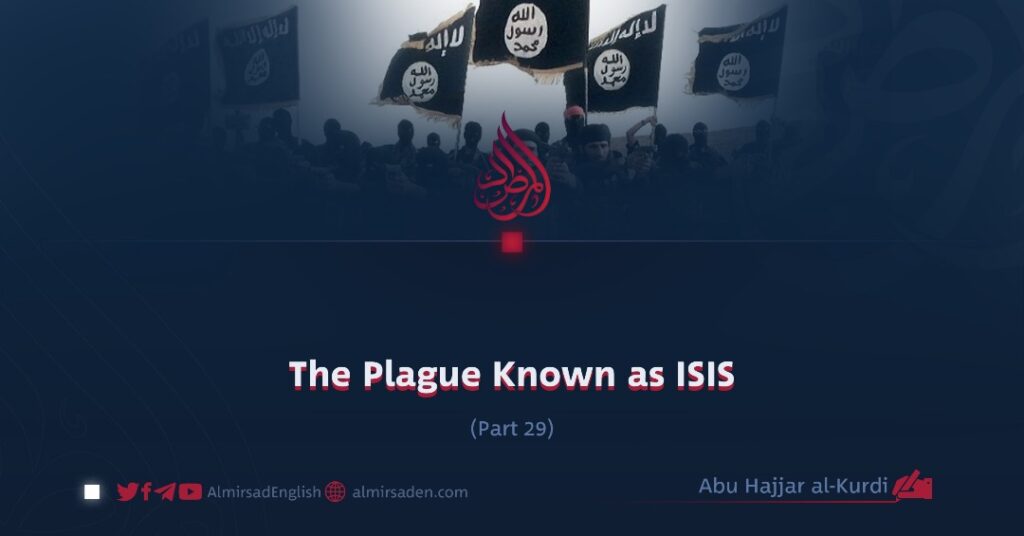Part 29
Abu Hajjar al-Kurdi
The consequences of ISIS’s actions in Iraq remain a deep and indelible stain on the record of its leaders and commanders, one that time cannot erase. A full examination of these events will require years of careful study, archival research, and testimony. Conveying the complete weight of this history lies beyond the capacity of a single individual such as myself.
This part presents a concise overview of ISIS’s actions in Iraq. Our focus here is limited to the group’s crimes and their consequences within Iraqi territory. In later parts, we will examine how ISIS extended its presence into other Muslim countries. What follows is a summary presented with clarity, sincerity, and restraint.
Between 2013 and 2019, I compiled a chronological record of ISIS’s rise, its period of maximum territorial control, and its eventual collapse. Alongside each major development, I noted the social, political, and psychological effects on Iraq’s Sunni population. The timeline integrates historical, military, and social perspectives.
Timeline of ISIS’s Emergence, Peak, and Decline in Iraq
2013 (Autumn to Winter)
Event: The battles of Fallujah and Ramadi during widespread Sunni protests against the government of Nouri al-Maliki and its discriminatory security policies.
Impact: Jihadist groups crossed over from Syria into western Iraq, intensifying already deep political and sectarian divisions.
January 2014
Event: ISIS seized control of Fallujah and parts of Ramadi, establishing its first formal foothold in Sunni-majority regions.
Impact: Several tribes at first believed ISIS might support them against central government, but soon discovered that its rule meant domination through executions, coercion, and fear.
July 2014
Event: The fall of Mosul triggered a rapid wave of ISIS expansion across Nineveh, Salahuddin, and Kirkuk, forming the most severe security crisis since 2003.
Impact: Many Sunnis initially welcomed the collapse of state control, yet soon suffered imprisonment, torture, and mass killings under ISIS authority.
June to July 2014
Event: Proclamation of the so-called Islamic Caliphate and the appointment of Abu Bakr al-Baghdadi as its leader.
Impact: The announcement generated widespread propaganda across parts of the Sunni world. For Iraqi Sunnis, however, it resulted in the elimination of local autonomy and the imposition of a harsh and absolute form of governance.
Late 2014 to Early 2015
Event: Anti-ISIS military operations in Diyala and Salahuddin involving the Rafidi Popular Mobilization Forces and the Iraqi Army.
Impact: Cities such as Tikrit were retaken, though fighting caused significant casualties among Sunni civilians and further inflamed sectarian distrust.
May to December 2015
Event: The battle for Ramadi in Anbar Province.
Impact: Iraqi troops, supported by Sunni tribal forces and international coalition air operations, reclaimed the city. Large-scale destruction left vast numbers of people displaced and reconstruction efforts slow.
May to June 2016
Event: The recapture of Fallujah, the first major city wrested back from ISIS.
Impact: Numerous Sunni families faced collective punishment and arbitrary detention at the hands of allied militias.
October 2016 to July 2017
Event: The offensive to retake Mosul, the most extensive urban battle in the region since the Second World War.
Impact: More than one million civilians were trapped throughout the fighting. After nine months, Mosul fell on July 10, 2017, marking a decisive turning point against ISIS.
August 2017
Event: Liberation of Tal Afar.
Impact: The organized presence of ISIS in Nineveh Province effectively collapsed. Many families were prevented from returning to their homes under accusations of complicity.
September to October 2017
Event: The Hawija operation in southern Kirkuk.
Impact: The last major urban territory held by ISIS in Iraq was retaken. In December 2017, Prime Minister Haider al-Abadi formally declared the end of ISIS’s territorial rule.
2018
Event: ISIS regrouped in the deserts of Anbar and along the Iraq-Syria frontier.
Impact: The group transitioned from a territorial entity to an insurgency. Sunni tribal influence in security operations remained restricted.
March 2019
Event: The fall of Baghuz, ISIS’s final stronghold in Syria.
Impact: The territorial caliphate collapsed in both Iraq and Syria. Abu Bakr al-Baghdadi later returned to Iraq but was killed in a United States raid in Idlib at the end of 2019.
2020 to 2024
Event: Remaining ISIS cells continued to operate in Iraq’s desert and mountain regions.
Impact: These cells conducted sporadic attacks but no longer controlled territory. Reconstruction of Sunni areas proceeded slowly amid ongoing discrimination and economic hardship.
Summary
Period of Maximum Strength: Summer 2014 to Summer 2015
Period of Territorial Collapse: July to December 2017
